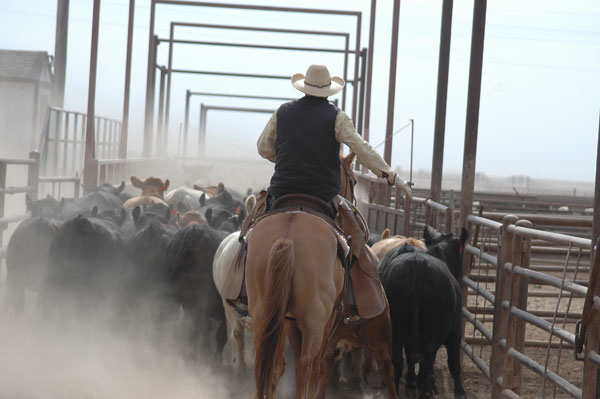For a feedyard horse, a day in the pens is no day in the park. It takes a special horse to handle the rigors of daily life in a feedyard.
December 20, 2016

Neither snow, nor rain, nor heat, nor gloom of night keeps these sentries from taking care of cattle. Indeed, a feedyard cowboy and his horses are one of the greatest examples of teamwork.
However, neither their horses nor the cowboys are groomed for the show ring. The perfect feedyard horse - durable, coarse, big-boned with big feet - won’t win any beauty contests. “But they’re good-minded, they’re solid, and they put up with a lot,” says Kevin Dwyer, manager of Sellers Feedyard at Lyons, Kan.
At any given moment, there are around 11 million cattle on feed nationwide being pampered so they’ll make consumers the tastiest hamburgers, roasts and steaks. Feedyard horses spend most of their time patrolling pens while their Wrangler-clad riders scout for and doctor sick or injured cattle. The rest of the time, they’re moving critters from one pen to another.
And feedyard work, at least for a horse, is fraught with noise and commotion—slamming gates on semi-trucks, the grinding gears of feed trucks and that annoying “beep-beep-beep” of backing trucks and tractors. The horses become acclimated to the noise and extremes.
So not only do feedyard horses need to know the basics - stop, back, turn around, sidepass - to be able to open and close gates, quietly sort a single steer from a pen or push a load of cattle down an alleyway, but they need to be able to handle the conditions a feedyard dishes out. They can be up to their fetlocks in mud or trodding on ground as hard as concrete.
“It’s asking a lot of a 2- or 3-year-old to do the kinds of things we expect,” says Dwyer. “You’ve got to have a horse that can stand getting poked in the ribs once in a while by a gate handle or steer and not come unglued.”
It’s no place for a green-broke horse. Well, it used to be until horse-related workman’s compensation claims started piling up. Cowboys were getting hurt because they lacked good horsemanship skills or were using horses that didn’t have the basic abilities required to work in feedlot.
“These days, the guys that come to work in the feedyard are either good sick-cattle detectors or good horsemen, not both,” says Jerry Riemann, horse trainer and retired feedyard manager from Dighton, Kan.
Because of this, and to reduce workman’s comp claims, a lot of feedlot managers send their cowboys to special safety seminars to learn horsemanship principles and understand what’s safe and what’s not. These days, the feedlot - formerly a factory for well-broke horses - has become a consumer of well-broke horses.
You May Also Like



